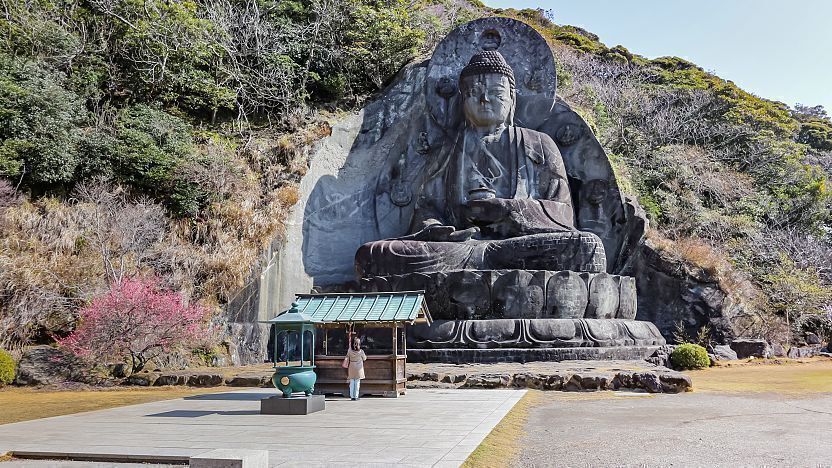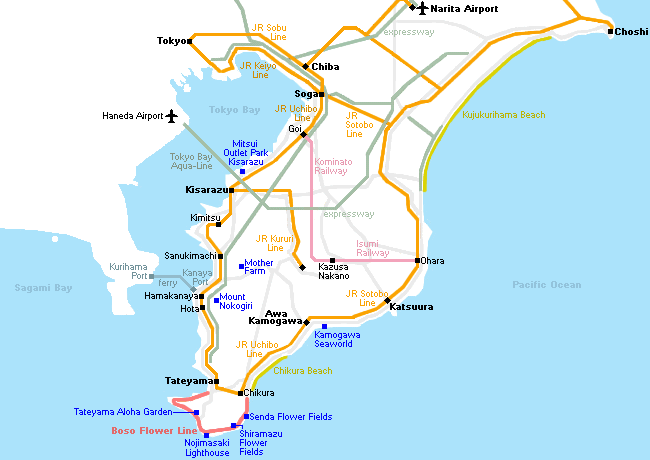Mount Nokogiriyama

Mount Nokogiriyama (鋸山) is a 330-meter tall mountain along the western coast of the Boso Peninsula. Spread out along the slopes of the mountain is Nihonji Temple (日本寺), a Soto Zen Buddhist temple, which was commissioned about 1300 years ago, making it one of the oldest sites of worship in the Kanto Region. The complex is extensive and consists of multiple areas, connected by a network of walking paths. It takes over an hour to explore them all.

There are various entry points into the temple grounds. The regular approach starts at the bottom of the mountain; however, most people enter further up via parking areas or by ropeway as most of the temple's main attractions are located at higher altitudes. The temple's main attraction, a 31 meter tall Daibutsu (Big Buddha), stands midway up the mountain. The stone statue depicts the Yakushi Buddha and was carved here over three years from 1780.
Lining the walking paths further up the mountain are 1500 statues of Buddhist disciples (rakan), carved out of stone over 20 years by the same master artisan who created the Daibutsu. These smaller statues are found in various nooks around the mountain, in different poses. Unfortunately, many of them were beheaded during the anti-Buddhist movement that accompanied the Meiji Restoration, but there are ongoing efforts to repair them.

Towards the top of the mountain stands a 30-meter tall Hyaku-Shaku Kannon, depicting the Buddhist Goddess of Mercy. Carved in 1966 into a stone cliff, it is dedicated to those who died in wars, of sickness or in accidents. The Kannon is also worshiped as a protector of transportation due to its protected location surrounded by rocks.
At the peak of the mountain are a couple of viewpoints, including the "Jigoku Nozoki" (Hell Lookout), offering views from a rock jutting off of a sheer cliff. From the peak, you can enjoy views of the Boso Peninsula and Tokyo Bay, and see Mount Fuji and the Skytree on clear days.

Getting there and around
By train
Take the JR Uchibo Line to Hama-Kanaya Station and walk 10 minutes to the lower station of the Nokogiriyama Ropeway which lifts visitors close to the peak of Nokogiriyama (1200 yen round trip, 650 yen one way). Alternatively, the main entrance to Nihonji Temple at the base of the mountain can be reached in about a 45 minute walk or a short ride by an infrequent bus from JR Hota Station.
By ferry
The Tokyo Bay Ferry which connects Kurihama on the Miura Peninsula with Kanaya on the Boso Peninsula lands just a ten minute walk away from the Nokogiriyama Ropeway's lower station. Ferries operate roughly hourly and take 40 minutes to make the crossing. The one way fare is 900 yen for passengers and around 4400 yen for a regular-sized car.
By car
There are two roads that lead to Nokogiriyama, a toll road and a toll-free road. The toll road (1000 yen, including parking fee) leads to parking lots toward the top of the mountain, while the toll-free road ends further down the mountain, not too far from the Daibutsu.
How to get to and around the Boso Peninsula

Hours and Fees
Hours
Closed
Admission
Questions? Ask in our forum.


